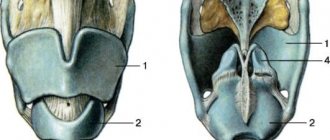Speech is a complex motor skill implemented by a large number of anatomical structures. The structure of the human vocal apparatus includes the organs of the respiratory system, larynx, tongue, teeth, etc. If the integrity of any of them is violated, the sound production process is disrupted. Knowledge of the anatomical structure and operating principle of the articulatory organs is important not only for singers or other professions related to music, but also for ordinary people. Speech disorders can occur in both children and adults, leading to disruption of the processes of social adaptation and learning.
Causes of pharyngeal cancer
The following are the main causes of throat cancer:
| Causes | Description |
| Smoking | Tobacco products containing harmful substances contribute to the development of the disease |
| Alcohol | Alcohol-containing products weaken the body and damage the immune system if abused. |
| Lack of oral hygiene | Lack of care and hygiene increases the risk of developing throat cancer |
| Heredity | If there are people in your family with throat cancer, the likelihood of it occurring in the future generation increases |
| papillomavirus | Infection increases the likelihood of developing cancer. |
How much do you have to smoke to get throat cancer? Studies conducted by scientists have found a connection between the number of cigarettes smoked per day, smoking experience and the likelihood of throat cancer. The higher the first 2 indicators, the higher the risk of cancer. Other forms of tobacco use also increase risk. There is a potential risk of laryngeal cancer in both smokers and those who chew tobacco. In individuals who have both of these habits, the risk of developing throat cancer increases by 3-4 times. Excessive consumption of strong alcoholic beverages is the first reason that increases the risk of developing the disease.
Laryngeal cancer associated with human papillomavirus has characteristic biological features. In its treatment, less aggressive organ-preserving chemotherapy regimens are used. How long does it take for throat cancer to develop? The process of transformation of normal cells into atypical ones is individual for each person. Throat cancer does not develop immediately. It is preceded by long-term precancerous diseases:
- Dyskeratoses of the larynx (leukoplakia, leukokeratosis);
- Pachydermia;
- Fibroma;
- Papillomas;
- Cysts;
- Chronic inflammatory processes in the larynx, which are accompanied by frequent alcohol consumption and smoking;
- Scars of the larynx as a result of illnesses or injuries.
The cause of the development of laryngeal cancer may be exposure to harmful factors at work, a weakened immune system, ionizing radiation, or gastroesophageal reflux disease.
Provoking factors are paints, wood dust, asbestos, sulfuric acid, nickel. How quickly does throat cancer develop? It may take months or years from the appearance of the first changes in the cells of the mucous membrane of the pharynx or larynx to the clinical stage of the disease.
Recently, in Russia there has been an increase in the number of newly diagnosed throat cancers. This is due to the influence of external and internal factors. Around the world, the statistics are no less comforting. Every year 15,000 new cases of pathology are diagnosed. The ratio of sick men to women is 1000:8.
Preventing neck pain
It is easier to prevent any problem than to solve it. Same with the neck. We adjust our lifestyle a little so that we don’t have to suffer from neck pain.
What is required for a healthy neck:
✓ Correct posture and kneading, straightening the back, turned and lowered shoulders, relaxed trapezius muscles
✓ Breaks in activity and warming up the neck muscles. Take a break from the computer and move around so that your muscles don't stagnate.
✓ When talking on the phone, do not hold it between your shoulder and ear.
✓ Do not carry large, heavy bags with straps over your shoulder.
✓ During sleep, keep your head at the same level as your body, change your position. Ideally, love sleeping on your back.
✓ Avoid drafts, air conditioning, hypothermia.
✓ Be attentive to your health during the period of exacerbation of colds.
What are the first signs of throat cancer?
The first signs of throat and larynx cancer are very varied. They depend on the shape and location of tumor growth and the degree of its spread. The initial stage of throat cancer is hidden. The first symptoms of throat cancer are mild. If they are present, you must immediately make an appointment with an otolaryngologist.
What does throat cancer look like in its early stages? Initially, the tumor can be in the form of a nodular or papillomatous formation, a polyp, or diffuse infiltration. The surface of the tumor is usually uneven and may be gray, red or dark. Cancer of the laryngeal ventricle first appears as a small, gradually increasing upward bulge of the ventricular ligament. Cancer of the epiglottis appears in the form of a limited infiltration or a lumpy, mushroom-shaped mass on its laryngeal surface, spreading into the preepiglottic space.
The first signs of laryngeal cancer depend on the location of the tumor. In the early stages of cancer of the middle part of the larynx, where the vocal cords are located, the first symptoms of throat cancer are hoarseness and other voice changes. The sensation of a lump or foreign body in the throat intensifies while eating or swallowing water.
Swallowing dysfunction occurs when the tumor is localized in the epiglottis. First, a sore throat appears, radiating into the ear on the affected side when chewing, and then there is a constant feeling of a foreign body in the throat. Because of the pain, the patient begins to eat less, which leads to weight loss and exhaustion of the patient.
Anatomical structure
To understand the functions of the larynx, it is necessary to clearly understand its anatomical structure.
Cartilage
The components of the organ in question are paired cartilages:
- thyroid,
- ring,
- epiglottis.
Among the unpaired cartilages the following stand out:
- arytenoid,
- cricoid.
The cartilages presented above are interconnected by ligaments and joints, due to which they can move, facilitated by the muscles of the larynx.
The cricoid cartilage looks like a ring, its ring looks forward, the “stone” looks back. Next, the thyroid and arytenoids are attached. The largest is the thyroid. It forms walls. Their parts are plates that stand at an obtuse angle in women, and at an acute angle in men (due to which the “Adam’s apple” protrudes).
The arytenoid cartilages are a pyramid, the base of which is attached to the cricoid cartilage. Two types of processes extend from the arytenoids:
- muscular,
- voice.
The muscular process controls the arytenoid cartilage, causing the vocal process to change position and influence the attached vocal cord.
- What is the human pharynx and oropharynx: structure, functions
All of the listed cartilages are hyaline, that is, they have the following characteristics:
- density,
- glassiness,
- elasticity.
They show a tendency to ossify. Ossification can occur as an age-related change, which affects the timbre of the voice.
Epiglottis
This part is a kind of “lifting shield” above the entrance of the laryngeal opening. From below, the epiglottis adjoins the thyroid cartilage. The main function representing the operation of this part of the system under consideration is to protect the respiratory entrance from foreign particles entering the lungs by closing its entrance.
Vocal cords
The ligaments are the primary mechanics that produce sound, traveling from the vocal processes to the thyroid cartilage. Between their pair there is a gap that allows a stream of air to pass through when a person breathes.
Laryngeal muscles
The muscles of this system are divided into large groups:
- internal, whose role is to guide the vocal cords,
- external, controlling the movements of the pharynx.
Intrinsic muscles exhibit a special distribution pattern:
- sound laryngeal, that is, the main adductors, there are only three of them,
- abductor - one muscle,
- cricothyroid muscle, which controls the tension of the ligaments.
Each type of muscle listed above performs a number of functions:
- the abductor expands the glottis, if it is damaged, this threatens the loss of speech abilities,
- adductors are responsible for narrowing the glottis, paired and unpaired types of muscles work simultaneously,
- The cricothyroid muscle controls the thyroid cartilage upward and forward, exerting proper tension on the ligaments.
The extrinsic muscles of the larynx are classified as:
- sternothyroid,
- thyrohyoid,
- thyroid.
The coordinated work of these muscles makes it possible to carry out movements of the pharynx during swallowing, breathing, and speech production.
- Cricoid unpaired cartilage of the larynx: its structure and functions
The main function of muscles is to change the position of the cartilage of the organ. The muscles of the larynx, according to the nature of their action on the glottis, are divided as follows:
- expanding,
- narrowing,
- changing the tension of the ligaments.
Thanks to the work of the muscles, the entire work of the system in question is carried out. Without them, breathing, respiratory protection, and speech production are impossible.
Laryngeal cavity
The cavity has an hourglass shape. The middle part, which is greatly narrowed, contains folds of the vestibule, or the so-called false vocal folds. The vocal cords are located below. On the sides are the ventricles, which are atavistic in nature. In some animals, such bags are very developed and serve as resonators.
The entire cavity, except for the ligaments, is lined with a mucous membrane consisting of ciliated epithelium, which reacts to the slightest touch thanks to a huge number of glands that cause a cough reflex when the mucosa is irritated by any foreign object. The mucous membrane covers the fibro-elastic membrane.
Symptoms
How does throat cancer start? At the beginning of the disease, there are no symptoms of the disease. Throat cancer manifests itself with common symptoms characteristic of oncology:
- A slight increase in temperature (up to 37.5°C);
- Drowsiness and constant fatigue;
- Weakness and general malaise;
- Fatigue quickly.
When the tumor of the throat and pharynx increases in size, symptoms characteristic of a malignant neoplasm appear. Signs of laryngeal cancer depend on the location of the pathological process.
What are the symptoms of throat cancer located in the vestibular part of the larynx? Initially, the patient does not show any complaints. As the laryngeal tumor progresses, the symptoms become specific. There is pain and discomfort when swallowing. This occurs due to deformation of the epiglottis and damage to the nerve endings. The epiglottis is deformed and does not completely close the entrance to the larynx. For this reason, the patient constantly chokes.
Malignant neoplasms of the vestibular region are aggressive. The tumor quickly spreads to surrounding organs and metastasizes to the lymph nodes of the neck. The reason for this is the well-developed lymphatic system of the vestibular region and its numerous connections with the lymphatic vessels of the pharynx.
What are the signs of throat cancer localized in the supraglottic part of the larynx? At the initial stage of development of cancer of the supraglottic larynx, there are no symptoms or manifestations of the disease. As the size of the tumor increases, the patient's voice changes and discomfort is felt when swallowing. When the tumor grows into the surrounding tissues, acute pain appears during swallowing, which radiates to the ear and hoarseness of the voice.
What are the symptoms of throat cancer when the pathological process is localized on the vocal cords? With this location of the malignant tumor, pain appears even with a small size of the tumor. The patient experiences the following symptoms of throat and larynx cancer:
- The voice is impaired;
- Hoarseness and hoarseness appear;
- Sonority and melody are lost.
The patient begins to get tired even after a short conversation. If the tumor grows into the lumen of the glottis, the patient's breathing becomes impaired.
Cancer of the middle part of the larynx has the most favorable course. The lack of lymphatic vessels in this area explains the rare metastasis of malignant tumors. Hoarseness, which occurs even with small tumor sizes, forces a person to consult a doctor soon after the onset of this symptom.
How does throat cancer manifest if the tumor is located in the subglottic region of the larynx? Malignant tumors in this area also have a number of features:
- Endophytic growth form;
- Resistance to ionizing radiation;
- Metastasis mainly to the preglottic and pretracheal lymph nodes.
There are no early symptoms of the disease. The first sign of laryngeal cancer is a dry, paroxysmal cough. After the tumor grows into the vocal cords, the patient's voice is impaired. As the pathological process progresses and the malignant tumor grows into the lumen of the larynx, the patient develops symptoms of throat and larynx cancer, such as breathing problems with attacks of suffocation. If the disease enters the final stage and begins to destroy surrounding tissues, putrid breath and a cough with blood clots appear.
How do you know if you have throat cancer? Malignant neoplasms of the pharynx and larynx do not have specific symptoms. Doctors at the Yusupov Hospital establish an accurate diagnosis after examining and instrumental examination of the patient. If there is throat cancer, symptoms of the disease, doctors take photos during the examination. It can be sent to a partner clinic and advice from other specialists can be obtained.
Stages of tumor formation in the throat
There are 4 stages of laryngeal cancer:
- The first stage - the neoplasm is localized in the mucous membrane. The tumor is limited and does not occupy the entire larynx. The neoplasm does not affect nearby tissues and organs and does not metastasize;
- The second stage - a tumor or ulcer occupies one entire section of the larynx, but does not extend beyond it. The mobility of the larynx is preserved. Metastases are not detected in regional lymph nodes;
- The third stage is divided into 3A and 3B. At stage 3a, the tumor spreads to adjacent parts of the larynx, causes immobility of the corresponding half of the organ, or, although it is limited to one floor of the larynx, it is accompanied by immobility of the ligament or arytenoid cartilage, or ligament. Stage 3B throat cancer is characterized by tumor spread to organs adjacent to the larynx and regional lymph nodes;
- Stage four – an extensive tumor occupies most of the larynx, infiltrates neighboring tissues, there are fixed metastases in the lymph nodes of the neck, or a neoplasm of any size with distant metastases.
With stage 1 throat cancer, patients develop a constant cough and the timbre of their voice changes. After properly selected treatment, tumor recurrence does not occur within five years in 80% of patients. Stage 2 of throat cancer is manifested by disruption of the vocal folds and breathing problems. The patient's voice becomes hoarse and there is pain when swallowing. The five-year survival rate is 70%.
Stage 3 throat cancer is manifested by a complete absence of voice due to damage to the vocal cords. With stage 3 laryngeal cancer, the life expectancy of 60% of patients is 5 years.
The diagnosis of stage 4 laryngeal cancer is manifested by symptoms of damage to the larynx and internal organs in which the metastases are localized (esophagus, lungs and bronchi, digestive organs). Metastases to the liver and brain are less commonly detected. Is it possible to cure stage 4 laryngeal cancer? With stage 4 throat cancer, life expectancy is short. Five-year survival rate is less than 25%.
Anatomy of speech
The vocal apparatus is a set of anatomical structures that provide the formation of voice and speech. In its structure, it is customary to distinguish two large sections: peripheral and central. The central section is represented by the brain, in particular, the cerebral cortex, a number of subcortical nodes and pathways connecting them together. In addition, it includes the nuclei of the cranial nerves, which are involved in sound production. The anatomy of the peripheral vocal apparatus includes bone, cartilage and muscle formations, ligamentous apparatus and peripheral nerves that perceive or transmit any information to the organs of articulation.
The peripheral department is divided into three functional departments that perform different tasks: respiratory, vocal and articulatory. If any of them malfunctions, speech disorders occur.
Respiratory section
The main sound-producing factor is air passing through the respiratory tract. In this regard, vocalists always practice proper breathing to improve the acoustics of their voice. Breathing movements are carried out reflexively; as a rule, in ordinary life a person does not think about when to inhale or exhale. The regulatory mechanism is associated with the respiratory center in the medulla oblongata.
The respiratory section includes both lungs, the tracheobronchial tree, the diaphragm and the intercostal muscles. The movements of the latter lead to expansion of the chest during inhalation and its narrowing during exhalation. The diaphragm is involved in the abdominal type of breathing, which is carried out mainly due to its stretching.
The formation of sounds and words occurs during exhalation. The air passing through the vocal and articulatory departments causes their structures to vibrate. If a person has lung diseases, the sound of speech is distorted.
Voice department
In phoniatry, there are three characteristics of any person’s voice: timbre, pitch and strength. All of them are created when the vocal cords vibrate as air passes through them. The amplitude of the vibration determines the strength of the voice. The stronger the vibration, the higher the sound. Timbre is determined by voice coloring, specific to each individual person. The tension of the folds and the degree of air pressure on them create a certain pitch of the voice.
One of the most common complaints from patients is changes in voice characteristics. Most often, this condition is associated with functional disorders that occur against the background of infectious and non-infectious diseases.
Sound department
The structure of the articulatory part of the vocal apparatus includes anatomical formations that are located in the oral cavity: the lower jaw, tongue, soft palate and lips. Movements of these structures are carried out with the help of muscles. If their work is disrupted, a person may develop various speech defects. Speech therapy exercises and massage allow you to train muscles, improving speech.
The tongue is the main articulatory organ. Its basis is striated muscles, which provide movement and change in shape. During a conversation, it can become longer, shorter, and also change its width. The structure of the tongue is divided into three parts: the root, fixed to the floor of the oral cavity, the back and the tip.
The lower and upper lips are movable structures. They participate in the pronunciation of almost all sounds, as they determine the speed of air flow from the oral cavity. Thanks to facial muscles, they can change their shape, which also plays an important role in the physiology of speech in humans. The mandible is located at the bottom of the skull and has a limited range of motion. Participates in the pronunciation of stressed vowels: “O”, “U”, “I” and a number of others.
The soft palate forms the upper border of the oral cavity and is tightly connected to the hard palate. Thanks to developed muscle fibers, it can rise and fall down. Anatomically separates the oral cavity from the nasal pharynx. It has a small tongue at the end. When pronouncing the consonants “N” and “M”, the velum is lowered. All other sounds are pronounced with the soft palate lowered. When movement is impaired, the voice becomes nasal, which is associated with the direction of air flow into the nasal cavity.
If a speech defect appears, you should not try to eliminate it yourself. Such treatment should be carried out by a speech therapist or doctor.
The articulatory apparatus also includes a number of passive structures: dentition, nasal cavity, hard palate and pharynx. They participate in sound pronunciation, acting as support points for the tongue and soft palate.
Diagnosis of laryngopharyngeal cancer
How to diagnose throat cancer in the early stages? If there are symptoms of throat cancer, diagnosis should be comprehensive. Doctors at the Yusupov Hospital diagnose cancer of the throat and larynx using the following methods:
- Direct and indirect laryngoscopy,
- Hypopharyngoscopy;
- Computed tomography;
- Histological examination;
- Trial laryngofissure;
- Cytological examination of prints from the larynx and lymph nodes;
- Determination of tumor marker levels.
How to recognize throat cancer? Otolaryngologists first perform indirect laryngoscopy. When examining the true vocal cords, attention is paid to their mobility during phonation and the asymmetry of the lesion inherent in the tumor process, and the size of the tumor lesion and its location are specified. To examine the posterior parts of the larynx, they are examined with a laryngeal mirror from bottom to top, when the doctor sits in front of a standing patient.
How to diagnose throat cancer in an elderly person if the picture is not clear enough or if the tumor is masked by secondary inflammatory phenomena with decay, infiltration and edema? In this case, otolaryngologists resort to local anesthesia, elevating the epiglottis, palpating with a probe, using a magnifying mirror, and also tilting the patient’s head accordingly. If a lesion of the subglottic region or lower parts of the pharynx is suspected, direct laryngoscopy and hypopharyngoscopy are used.
How to check your throat for cancer using computed tomography. This research method expands diagnostic capabilities for tumors that are localized in the area of the ventricular and true vocal cords and laryngeal ventricles, as well as when the tumor has spread to the subglottic region. At the Yusupov Hospital, patients are examined using the latest generation computer tomographs with high resolution capabilities.
How to check the throat and larynx for cancer using laboratory methods? Histological examination determines the nature of the tumor, its structure, the degree of differentiation of cellular elements and the degree of malignancy of the tumor - all these details influence the course of the disease and are taken into account when choosing a treatment method
To avoid stimulation of increased growth and spread of the tumor process due to damage to the lymphatic and blood vessels during biopsy, oncologists perform several sessions of radiation therapy before surgery.
How to diagnose laryngeal cancer using other methods? In cases where the biopsy data are not convincing enough or it is impossible, a trial laryngofisure is used. Since during the procedure, contamination of surrounding tissues with atypical cells may occur, in such cases, a histological examination is urgently performed at the operating table, having previously obtained the patient’s consent for radical intervention. Cytological examination of prints from the larynx and lymph nodes is carried out in cases where the patient categorically refuses surgery and a biopsy is not indicated.
How to detect throat cancer at an early stage? For early diagnosis of throat and larynx cancer, doctors at the Yusupov Hospital examine the level of tumor markers SCC and CYFRA 21-1. Highly qualified doctors, equipping operating rooms with modern diagnostic equipment and instruments allows oncologists at the Yusupov Hospital to improve five-year survival rates for throat cancer.
How to treat laryngeal cancer? Doctors at the Yusupov Hospital have extensive experience in treating laryngeal cancer. The treatment method is selected depending on the stage of the disease, type and spread of the tumor. The following methods are used:
- Surgical interventions (chordectomy, laryngectomy);
- Organ-preserving laser surgery for laryngeal tumors;
- Operations to remove tumors using a shaver;
- Radiation treatment (external gamma therapy);
- Neoadjuvant, adjuvant and curative chemotherapy;
- Palliative treatment.
Expert opinion
Author: Alexey Andreevich Moiseev
Head of the Oncology Department, oncologist, chemotherapist, Candidate of Medical Sciences
Throat cancer accounts for 3% of all cancers. At the same time, the tumor is the most common among neoplasms of the upper respiratory tract. It is diagnosed in 50–70% of cases. As throat cancer progresses, permanent disability occurs. As a result, the tumor remains a problem for clinical medicine.
Recently, in Russia there has been an increase in the number of newly diagnosed throat cancers. This is due to the influence of external and internal factors. Around the world, the statistics are no less comforting. Every year 15,000 new cases of pathology are diagnosed. The ratio of sick men to women is 1000:8.
The Yusupov Hospital provides a full course of diagnostics necessary to identify pathology even at the formation stages. The earlier the examination is performed, the more favorable the prognosis. The quality of treatment meets international standards. An individual therapy and rehabilitation program is developed for each patient, aimed at improving the quality of life and preventing relapse.
The main treatment method for laryngeal cancer is surgery. Radical surgical intervention for a malignant tumor is removal of the larynx. The consequences may vary. After surgery, some patients lose their voice and tumor growth resumes.
A laryngofissure is applied when the exophytic tumor is localized on the free edge of the anterior two-thirds of the true vocal cord, without the tumor spreading to the anterior commissure and the arytenoid region.
If a significant area of the larynx is affected by the cancer process, and mobility in the affected area is very limited or even completely absent, the process is macroscopically one-sided, surgeons perform throat surgery for oncology - resection of half of the larynx. Hemilaryngectomy is indicated not only for internal cancer that does not grow through the cartilage of the larynx, but also when the tumor process has spread to the anterior commissure and the area of the arytenoid cartilage.
If the tumor is localized in the anterior two-thirds of one true vocal cord with transition to the anterior commissure or even to the anterior part of the other true vocal cord, a half resection of the larynx according to Otan is performed. During this operation, the anterior parts of the larynx are removed, leaving its posterior wall. After the intervention, swallowing and voice function are preserved. Partial surgical interventions for laryngeal cancer include frontal resection of the larynx. It is used for damage to the anterior commissure.
Currently, the most common organ-preserving operations for localized laryngeal cancer remain chordectomy and diagonal resection of the larynx. After surgery, patients' voice function is impaired; they note hoarseness, fatigue during conversation, and a significant deterioration in sound when overloaded. An undesirable consequence of sagittal resection of the larynx is a disorder in swallowing after surgery.
How to cure throat cancer at an early stage? Laryngeal surgery (tumor removal) is performed using a shaver. During the operation, healthy tissue is not injured. The operation is performed endoscopically. A tracheostomy for laryngeal cancer is performed after total removal of the organ. The Yusupov Hospital provides nutrition after removal of the larynx for throat cancer.
Throat cancer is treated with anticancer drugs. Oncologists practice two treatment options: monotherapy and polychemotherapy. In monotherapy, one drug is used, to which cancer cells are especially sensitive. The drug is prescribed in large doses. For polychemotherapy, several cytostatic drugs are used sequentially or simultaneously.
Chemotherapists at the Yusupov Hospital use combinations of cytostatics recommended by the International Association of Oncologists to achieve the greatest effectiveness of treatment. They use drugs that are highly effective and have minimal side effects. Patients at the Oncology Clinic have the opportunity to receive the latest anticancer drugs thanks to a research program in which the Yusupov Hospital participates. The effectiveness of radiation therapy for throat cancer is assessed by professors and doctors of the highest category.
A combined approach to the treatment of laryngeal cancer can improve treatment results. Radiation therapy for throat cancer is used both as primary treatment and as part of combination therapy. Is there a cure for throat cancer? Most patients with early stages of laryngeal cancer are cured with radiotherapy. How suitable radiation therapy for laryngeal cancer is for a particular patient depends on the volume and location of the tumor, and is determined by the depth of its growth in the throat tissue.
In the early stages of the disease, treatment in most cases is carried out with radiation sessions 5 times a week for 3-7 weeks. The radiotherapist calculates the total radiation dose to laryngeal cancer for the entire course, and then divides it into fractions. This separation allows you to reduce the undesirable consequences of treatment. Can throat cancer be cured? If complex treatment is started on time, the prognosis for recovery improves many times over.
Diseases, pathologies, injuries of the throat and larynx: description
Diseases of the larynx
In order to promptly begin treatment for a particular problem associated with the pharynx, larynx or trachea, it is necessary to correctly recognize the symptoms. Only a doctor can do this. Let us highlight 4 main acute inflammatory diseases of this part of the body:
Acute catarrhal laryngitis - inflammation of the mucous membrane of the larynx:
- Occurs as a result of pathogenic bacteria entering the mucous membrane , as well as under the influence of exogenous and endogenous factors: hypothermia, eating too cold or hot food, prolonged conversation in the cold and other irritations of the mucous membrane. more about this disease in the article at this link .
- The first symptoms are a hoarse voice, soreness, an unpleasant feeling in the throat, and a dry cough.
- If the disease is not treated , various changes in the blood may occur, small cell infiltration appears, and the mucous membrane becomes saturated with serous fluid.
- Diagnosis of the disease is simple - visual examination. The doctor makes a diagnosis based on the symptoms: acute hoarseness, severe swelling of the mucous membrane, incomplete closure of the vocal folds. The disease can become chronic. Erysipelas of the mucous membrane also occurs, which can simultaneously occur with a disease of the facial skin.
- Treatment - if treatment is started in a timely manner and it is correct, then the disease will go away within 10 days. If the disease lasts more than 3 weeks, then there is a high probability that the disease will become chronic. It is important to remain silent during treatment until the symptoms begin to subside. Read the article at this link on how to treat laryngitis in children.
Laryngeal
sore throat is an acute infectious disease that affects lymphadenoid tissue:
- Etiology - inflammation is caused by bacterial, fungal and viral flora. It also occurs from hypothermia or injury. The pathogen penetrates the mucous membrane through airborne droplets or alimentary routes. In the article at this link you will learn everything about sore throat in children.
- Symptoms include a sore throat that gets worse with swallowing and turning the neck. Difficulty breathing, increased temperature - up to 39 degrees, and increased heart rate may appear. Upon palpation, enlarged lymph nodes of the throat are felt.
- Diagnosis - the clinical picture allows you to visually recognize the disease upon examination. But if such a sore throat is suspected, diphtheria, which has the same course, should be excluded.
- Treatment - antibacterial drugs, antihistamines, mucolic and analgesic drugs are prescribed. If stenosis occurs, then an emergency tracheotomy is prescribed. Read in the article at this link on our website how you can cure a sore throat with the help of rinses.
Laryngeal edema
Laryngeal edema is a rapidly developing vasomotor-allergic edematous process in the mucous membrane:
- Etiology - often manifests itself as a consequence after the manifestation of some disease: inflammation of the larynx, infections, tumors, injuries, allergies, various pathologies.
- Clinical picture - the lumen of the larynx and trachea narrows due to spasm, foreign body entry, and infections. Moreover, the faster stenosis develops, the greater the danger it poses to health. Read the article on our website about how sore throat in children can cause swelling of the larynx and what needs to be done after that.
- Diagnosis - the laryngoscopic picture helps to make the correct diagnosis. But it is important that the doctor finds out why the swelling appears. After all, the edematous membrane can cover an existing tumor or foreign body. Therefore, the doctor usually prescribes bronchoscopy, x-rays and other studies.
- Treatment - medications are prescribed that will help cope with bacteria: broad-spectrum antibiotics. It is important to restore external breathing during treatment. If drug treatment does not help, then a tracheostomy is performed. This procedure is necessarily prescribed for decompensated stenosis. You also need to limit fluid intake, try not to talk a lot and limit physical activity.
Acute tracheitis
Acute tracheitis is an inflammatory process of the mucous membrane in the lower respiratory tract:
- The causes are pathogenic bacteria that enter the body and, against the background of reduced immunity, begin to progress. In winter, immunity weakens, especially when hypothermia occurs or during viral infections, occupational hazards, and so on.
- The clinical picture is a paroxysmal cough with the discharge of purulent sputum, swelling of the mucous membrane, dilation of blood vessels on the mucous membrane. Fever, weakness, poor health, hoarseness - all these are the first signs of tracheitis.
- Treatment - expectorants, antihistamines, and medications to reduce fever are prescribed. If the temperature does not go away and rises within 3-4 days, then antibiotics are prescribed. The article at this link describes how tracheitis can be cured using mustard plasters.
- Prognosis - if treated correctly, the disease goes away within 2-3 weeks. If treatment is incorrect, then the disease can develop into a chronic form. Complications such as pneumonia or bronchopneumonia may also occur.
There are many diseases of the pharynx, larynx and trachea. Only a doctor can recognize and make the correct diagnosis. Do not self-medicate, as this can lead to undesirable consequences and complications. Here is another list of common throat diseases:
Diseases of the larynx
A sore throat can also appear as a result of a concomitant disease. Here are the problems that lead to sore throat:
Problems that cause sore throat
The throat is the most complex part of the body. From the outside of this part of the body there are many blood vessels and nerves. All parts are important, both individually and together. Breathing, swallowing, eating - all these processes require an organ such as the throat, consisting of the pharynx, larynx and trachea.
Survival prognosis
How long do people live with laryngeal cancer? When a patient is diagnosed with throat cancer, the prognosis directly depends on the location of the tumor and the extent of the cancer process.
Table No. 1. Survival prognosis depending on the location of the laryngeal tumor
| Location of the tumor | Five-year survival forecast |
| Postcricoid region | 20% |
| Posterior wall of the larynx | 21% |
| Pyriform sinus | 50% |
Is throat cancer deadly? If the disease is recognized in a timely manner, there is a high probability that the disease can be defeated. The five-year survival rate for patients with stage 1 throat cancer is 85%. When stage 4 gora cancer is detected, the prognosis is less optimistic. If stage 4 throat cancer is detected, how long do they live? The five-year survival prognosis for patients with stage four laryngeal cancer is 20%. Much depends on whether the patient agrees to surgery to remove the larynx and vocal cords, which could render the person mute.
Long-term survival of patients with throat cancer has remained virtually unchanged over the past 20 years, but the quality of life of cured patients has improved significantly. If radiation therapy does not lead to the expected result, doctors at the Yusupov Hospital use preservation surgery methods that allow the patient to partially preserve speech.
Anatomy and functions of the trachea
Anatomy and functions of the trachea
So, the trachea connects the larynx to the bronchi, which means it carries air and oxygen into the lungs. The trachea is a hollow, tube-shaped organ. Its length ranges from 8.5 cm to 15 cm, depending on the physiological characteristics of the body. The third part of this tube is located at the level of the neck, the remaining part descends into the thoracic region. At the end, the trachea divides into 2 bronchi at the level of the 5th thoracic spine. A more detailed description of the trachea:
- The thyroid gland is located in front at the level of the neck.
- At the back is the esophagus.
- On the sides there is a cluster of nerve endings, carotid arteries and internal veins.
Anatomy of the trachea:
- The mucous membrane consists of a ciliated layer. Mucus is secreted on its surface in small quantities. Endocrine cells of the trachea secrete substances such as serotonin and norepinephrine.
- The submucosal layer consists of tiny vessels and nerve endings. This connective tissue has a fiber structure - loose and soft.
- Cartilages are hyaline incomplete cartilages that make up 2/3 of the entire trachea. The joints for the cartilage are special annular ligaments. The membranous wall, located posteriorly, is in contact with the esophagus. Thanks to this, the two processes - eating and breathing - do not interfere with each other.
- The adventitia is a thin shell in its structure, consisting of connective fibers.
The functions of the trachea are very important in the functioning of the body, despite the simple anatomy of this organ. The functions are as follows:
- The main purpose of this section of the larynx is to conduct air to the lungs.
- Small particles that are unnecessary for the body and come from the external environment settle on the mucous layer of the trachea. They are enveloped in mucus, and the cilia are pushed into the larynx.
As a result, the trachea cleans the air that the lungs need. From the larynx and pharynx, all the dirt that has been removed from the trachea rises up and with the help of coughing, all these organs are cleansed.
Prevention
Throat cancer is a disease whose development is largely associated with the consumption of alcohol, nicotine and other toxic substances. Oncologists recommend that patients addressing this issue give up bad habits to reduce the likelihood of pathology.
Another provoking factor is carcinogenic substances, the inhalation of which causes irreversible changes in the mucous membranes. Patients at risk are advised to limit manipulations with substances of increased carcinogenicity: benzene, asbestos, oil industry products, phenolic resins, coal dust. If, while performing work duties, contact with these substances cannot be avoided, respirators should be used to protect the respiratory tract.
Timely treatment of respiratory diseases is an important preventive measure to prevent the pathological process. Oncologists at the Yusupov Hospital advise patients at risk and inform them about factors that negatively affect the respiratory tract, manifestations of throat cancer at the initial stage and methods of prevention.
Neck structure and pain: how they are connected
Pain in the neck area can be aching, sharp, shooting, or throbbing. When tilting the head, turning or touching, the sensation may intensify. It can be localized on the right, left, front or back. Because of it, mobility may be limited, and sometimes the head is in the so-called forced position. Often pain in the neck is complemented by pain in the head, back of the head, right and left shoulders, arm, back, heart, face.
Do you know how your neck works and what exactly can hurt you? Well, let's fast forward a few minutes to the past, to an anatomy lesson in high school. Remember!
The neck consists of:
- The cervical spine, which is 7 vertebrae
- Muscles, 10 of them
- Bundles
- Larynx
- Thyroid gland
The cervical vertebrae are small in size and consist of a body and processes with attached ligaments and muscles. There are discs between the vertebrae. Discs have an outer part (hard, consisting of fibrous fibers) and an inner part (soft nucleus pulposus, which provides shock absorption to the spine).
Look at the picture. It clearly shows where which neck muscles are located.
The conclusion from this short excursion suggests itself. Neck pain can occur due to a malfunction:
- cervical spine,
- muscles and ligaments,
- internal organs (larynx and thyroid gland)
What kind of violations are we talking about? These may be spasms, inflammation, degenerative changes (degradation of tissues and organs), configuration disorders (for example, displacement of the vertebrae) and other types of anomalies. For example, pinching of the vertebral artery, spinal roots, and small vessels may occur.
And! Neck pain can become a side symptom of diseases of the heart, lungs, upper respiratory tract and other ailments.
Treatment in Moscow
Treatment of throat cancer in Moscow using modern methods is carried out by doctors at the Yusupov Hospital. The Oncology Clinic specializes in the treatment of laryngeal cancer. The consultation is conducted by leading oncologists in Moscow, who have scientific titles and the highest medical category. Candidates and doctors of medical sciences and authors of scientific works take part in the treatment process.
Patients are in comfortable rooms. Medical personnel provide hygienic care for the tracheostomy. Cooks provide patients with special meals. The cost of treatment is lower than in other throat cancer clinics. The price of services provided to the patient corresponds to their quality. You can find out how much treatment for throat cancer costs by calling the Yusupov Hospital.
Treatment of laryngeal cancer
There are two treatment options for throat cancer
– surgery and conservative treatment. A specific method is selected based on a combination of factors, primarily the location and size of the formation. Radiation and chemotherapy are often used initially. In most cases, in the first stages, conservative treatment gives positive results, and the larynx continues to function fully.
throat cancer treatment
Sometimes surgery may be necessary; now, for small tumors, only a small part of the larynx is cut out; in case of serious damage, the entire organ must be removed. Then you will need to restore your voice; exercises will have to be done for at least 2 months.
After recovery, it is necessary to be under the supervision of a doctor for several more years, as there is a possibility of relapse and all kinds of complications. During treatment, you should eat food rich in vitamins and microelements. You should avoid sweets, spices, spicy, fried, salty foods, because such foods affect the larynx.










